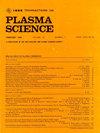Time-Resolved Investigations of the Capacitive to Inductive Transition in a Microwave-Driven Plasma Source
IF 1.3
4区 物理与天体物理
Q3 PHYSICS, FLUIDS & PLASMAS
引用次数: 0
Abstract
Measurement of resonances requires data acquisition at different frequencies. Tracing the evolution of a resonance, therefore, requires a long time for each step. Reproducible events allow us to record data in the time domain at different fixed frequencies and then to rebuild the resonance shapes at different times. Using this method, the ignition process and the transition from electrostatic to electromagnetic coupling (微波驱动等离子体源中容感性跃迁的时间分辨研究
共振的测量需要在不同的频率采集数据。因此,追踪一个共振的演变,每一步都需要很长的时间。可重复的事件使我们能够在不同的固定频率下记录时域内的数据,然后重建不同时间的共振形状。利用这种方法,研究了在不同气体(He, Ar, N2和O2)和压力(20-2000 Pa)下等离子体形成的点火过程和从静电耦合到电磁耦合(E-H)的转变。所使用的微波源提供了石英管内电感耦合等离子体(ICP)的微型模型,并且在有或没有等离子体的情况下在2.4-2.5 GHz范围内具有相对较窄的共振。仅容性耦合一段时间后,在低压下,两种谐振同时存在,表明存在容性耦合和电感耦合。在高压下,点火时间要长得多,并出现常见的混合共振。氦和氩显示共振频率的时间增加超过几十微秒对应于电感耦合,这意味着,在我们的全局模型中,电子密度的增长非常缓慢。相反,氮和氧表现出相对较长的电容耦合初始阶段,然后表现出稳定的电感耦合电子密度。此外,高压下的氧表现出一个平台,最初表明电子附着在氧原子上(O $^{-}$),然后在数百微秒后形成正氧离子。
本文章由计算机程序翻译,如有差异,请以英文原文为准。
求助全文
约1分钟内获得全文
求助全文
来源期刊

IEEE Transactions on Plasma Science
物理-物理:流体与等离子体
CiteScore
3.00
自引率
20.00%
发文量
538
审稿时长
3.8 months
期刊介绍:
The scope covers all aspects of the theory and application of plasma science. It includes the following areas: magnetohydrodynamics; thermionics and plasma diodes; basic plasma phenomena; gaseous electronics; microwave/plasma interaction; electron, ion, and plasma sources; space plasmas; intense electron and ion beams; laser-plasma interactions; plasma diagnostics; plasma chemistry and processing; solid-state plasmas; plasma heating; plasma for controlled fusion research; high energy density plasmas; industrial/commercial applications of plasma physics; plasma waves and instabilities; and high power microwave and submillimeter wave generation.
 求助内容:
求助内容: 应助结果提醒方式:
应助结果提醒方式:


